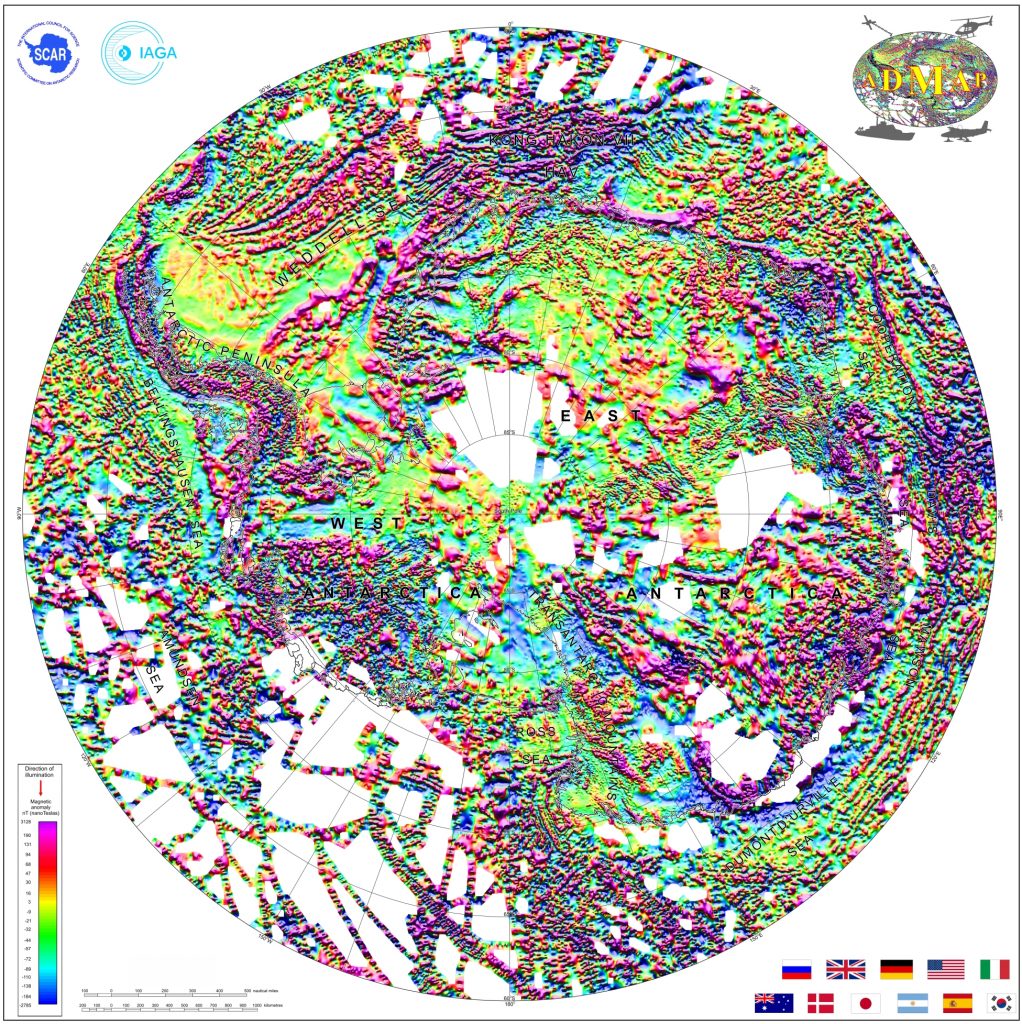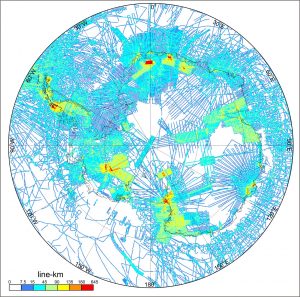17 July 2018
New magnetic anomaly map helps unveil Antarctica
Posted by kcawdrey
By British Antarctic Survey
The most comprehensive magnetic map of Antarctica ever produced was published online this week in a new study in Geophysical Research Letters, a journal of the American Geophysical Union.
The new map – which includes 3.5 million line-kilometers of magnetic anomaly data collected over the past 50 years – sheds new light on the structure and evolution of the Antarctic continent and its surrounding oceans.

New magnetic anomaly map of the Antarctic continent and surrounding oceans. Credit: Golynsky et al/American Geophysical Union
Antarctica’s remoteness and harsh conditions make it a supremely challenging environment for researchers who study the continent. For geoscientists, however, research is particularly tough because the rocks they seek to understand are buried deep beneath the thick ice sheet that blankets the continent.
Less than 1 percent of Antarctica’s geology is visible above its icy mantle, so in addition to using traditional geological mapping, geoscientists rely on magnetic anomalies to help them interpret the fundamental building blocks of the continent and their tectonic boundaries.

Map showing the location of the magnetic lines used for the ADMAP 2.0 compilation. Blue lines show the data included included in ADMAP 1. The new lines acquired by the international geophysical community since 2000 are shown in red. Credit: Golynsky et al./American Geophysical Union
The new map, ADMAP-2.0, uses data collected from aircraft and ships. It shows variations in Earth’s magnetic field caused by differences in the crust’s magnetisation, which help reveal the geology hidden beneath the Antarctic ice sheet and South Ocean.
ADMAP-2.0 doubles the coverage of the first version of ADMAP released in 2001. It includes data collected over previously unexplored sectors of Antarctica (e.g., Dronning Maud Land, Wilkes Land) and huge mountain ranges such as the Gamburtsev Subglacial Mountains and the Transantarctic Mountains. Both the new map and its datasets are freely available.
“The project shows the full potential of international collaboration to obtain such continental-scale compilations,” said Alexander Golynsky from VNIIOkeangeologia in Russia and lead author of the new paper. “By including large new datasets and using advanced re-processing and data merging techniques we have vastly improved the Antarctic magnetic anomaly map”.
“Our new map helps reveal the crustal architecture of the entire Antarctic continent with much more detail than before,” according to Fausto Ferraccioli, Science Leader at the British Antarctic Survey and co-chair of the ADMAP international steering committee. “It allows us to image many of the key geological features hidden under the thick ice sheets that blanket the continent.”

The map shows the magnetic anomaly data density available for the ADMAP 2.0 compilation. Red to greenish colors show regions where high to medium spatial resolution is now available. Note that several large areas in both East and West Antarctica lack such good data coverage. Some of the major remaining data gaps (white areas) are now a prime target for future international exploration. Credit: Golynsky et al./American Geophysical Union
The new map opens up exciting new research into the geological processes that led to the formation and evolution of Antarctica, which was once a centerpiece of Gondwana and earlier supercontinents such as Rodinia and Nuna, according to the study’s authors.
“Until now we have lacked a coherent geophysical compilation needed to trace much better-understood geological features from other continents into Antarctica. This fantastic new tool will help us answer many geological questions, such as how Gondwana broke apart and also help us understand how Antarctica’s geology influences the way in which its ice sheets flow today,” Ferraccioli explains.
“Our next challenge is to fill in the remaining magnetic data gaps by exploring the most remote frontier areas of Antarctica building on the success of our international collaboration,” said ADMAP co-chair Graeme Eagles from the Alfred Wegner Institute.
ADMAP-2.0 involved scientists from 22 institutions across 11 nations, and the Korean Polar Research Institute funded the map compilation.
— This post originally appeared as a press release on the British Antarctic Survey website.










 GeoSpace is a blog on Earth and space science, managed by AGU’s Public Information staff. The blog features posts by AGU writers and guest contributors on all sorts of relevant science topics, but with a focus on new research and geo and space sciences-related stories that are currently in the news.
GeoSpace is a blog on Earth and space science, managed by AGU’s Public Information staff. The blog features posts by AGU writers and guest contributors on all sorts of relevant science topics, but with a focus on new research and geo and space sciences-related stories that are currently in the news.
Gentlemen:
Great, now these data can be correlated with gravity data from EIGEN 6C4 and SatGravRET2014 with ground resolution 10 km and I found that they support our discoveries of candidates for subglacial volcanoes and lakes near the Lake Vostok and our confirmation of von Frese hypothesis about a giant impact crater under the ice of Wilkers Land.
We are interested in the data files to plot regions of our interest.
Kind regard
Jaroslav Klokocnik,
Astronom. Inst. Czech Acad. Sci.
CZ 251 65 Ondrejov Obs.
http://www.asu.cas.cz/~jklokocn (all our recent papers are there)